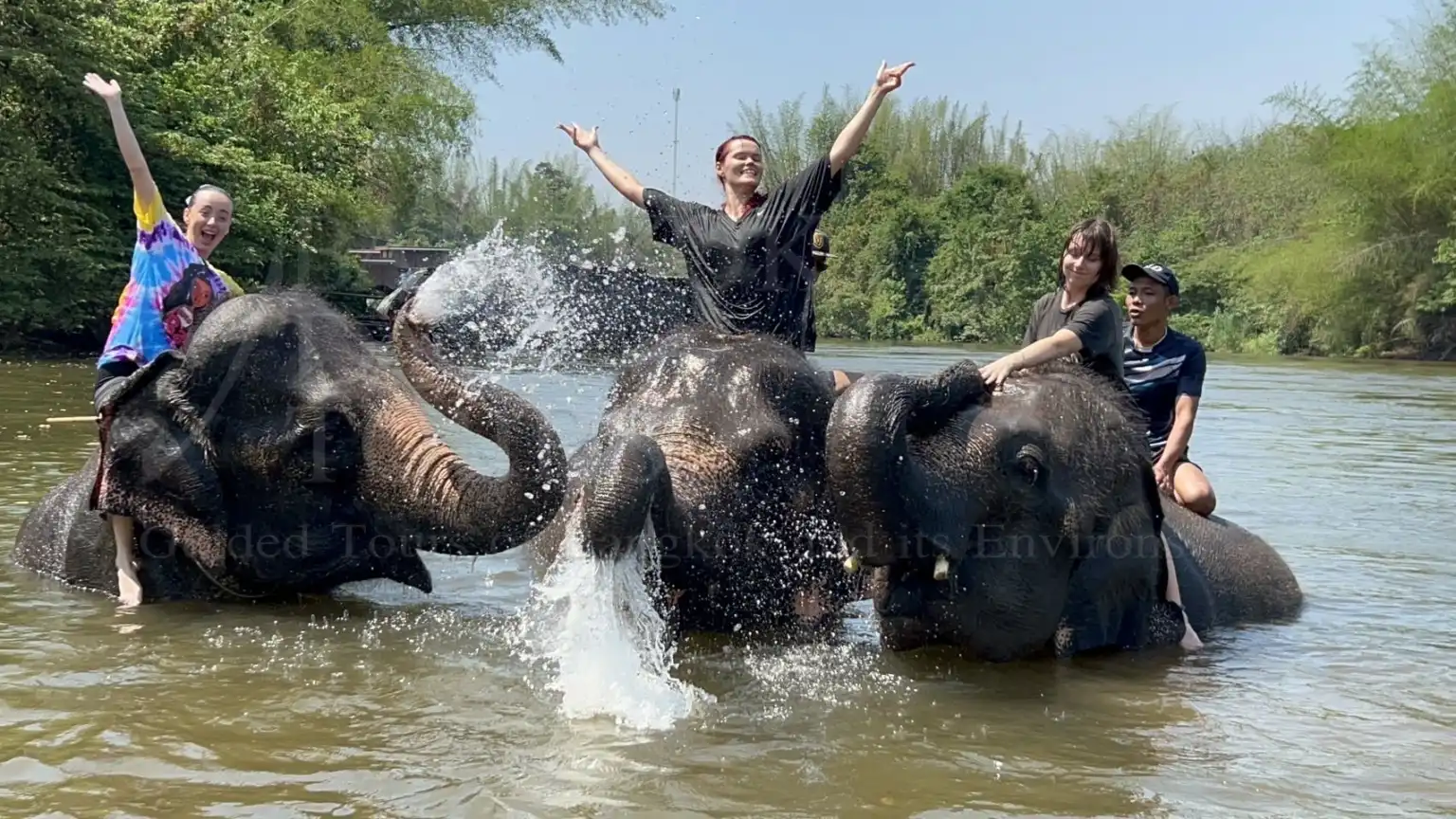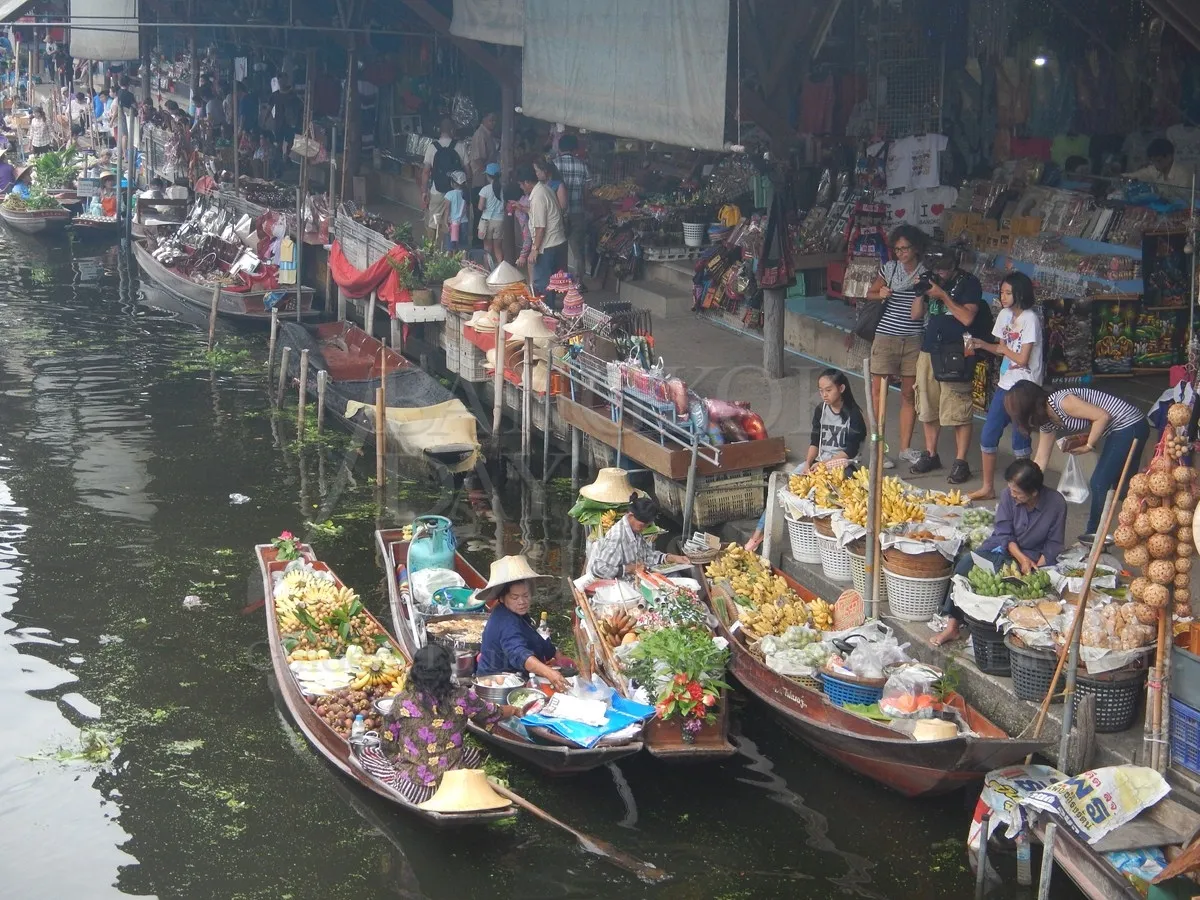
Attractions information
Floating Market Damnoen Saduak
Waterways have always been an integral part of Thai life and many communities depended entirely on them for their daily existence.
Long before cars, boats of all shapes and sizes plied the rivers and canals through the kingdom of Thailand, trading their wares and delivering their supplies.
The Floating Market at Damnoen Saduak is located in Ratchaburi Province which is just over 100 kms or two hours drive from the capital city of Bangkok.
This is a particularly fertile area, being irrigated by a 32 kilometre straight-line canal constructed by King Rama IV way back in 1866.
It connects the Taachin River with the Mae Klong River and became a major transport artery between the provinces of Samut Sakorn and Samut Songkram.
Apart from providing transportation, Damnoen Saduak Canal also provides year-round water, with more than 200 small canals having been dug by farmers to irrigate their land.
The area is famous for the quality of its fruit, namely grapes, mangoes, bananas, oranges, papaya & coconut.
Nowadays, both sides of the canal are densely populated and bright and early every morning vendors from the surrounding area turn up to trade their wares.
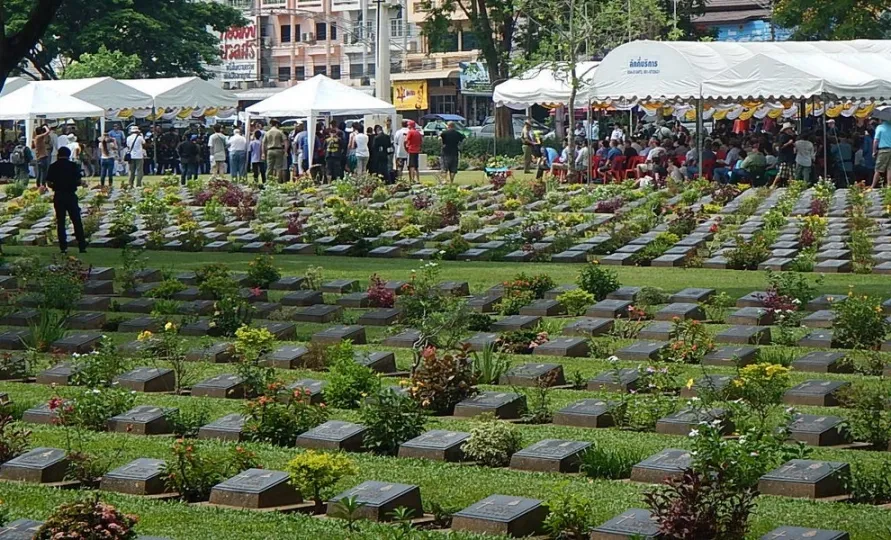
Attractions information
Don Rak War Cemetery Kanchanaburi
The Don Rak War Cemetery in Kanchanaburi is the final resting place of 6,982 Allied POWs who perished during the construction of the Death Railway during World War II.
There is another cemetery at Chungkai just outside Kanchanaburi.
Don Rak War Cemetery in Kanchanaburi is maintained in beautiful condition by the Australian Government and is a sober reminder of those who paid the supreme sacrifice so that we could live in peace.
The Kanchanaburi War Cemetery is only a short distance from the site of the former 'Kanburi', the prisoner of war base camp through which most of the prisoners passed on their way to other camps.
The graves are marked with horizontal bronze plaques set into the grass. Scarlet, purple and white bougainvillaea tumbles over the surrounding walls and flowering trees and shrubs dot the grounds. It seems a strange thing to say, but this is truly a beautiful place.
Within the entrance building to the cemetery will be found the Kanchanaburi Memorial, recording the names of eleven men of the army of undivided India buried in Muslim cemeteries in Thailand, where their graves could not be maintained.
The Don Rak War Cemetery is the location of the ANZAC Day Wreath-laying Ceremony held on 25th April each year.
Important Information
On wet days, the lawn cemetery is off-limits to the public.
If you wish to see a specific grave, please bring the number with you as there are two main cemeteries in Kanchanaburi.

Attractions information
Kanchanaburi Province
Kanchanaburi Province which borders Myanmar (Burma) to the north-west is the third largest Thailand's of seventy six provinces.
It is located 130 km west of Bangkok and has a population of about 735,000 of which 54,000 live in Kanchanaburi town itself. This is a most picturesque part of Thailand.
Kanchanaburi town was originally established by King Rama I as a first line of defence against the Burmese, who might use the old invasion route through the Three Pagodas Pass on the Thai-Burma border.
The magnificent landscape & charming beauty of Kanchanaburi have resulted in major tourist attractions including the well-known Erawan Waterfalls, caves which were once inhabited by Neolithic man, pristine national parks, tranquil rivers, virgin forests, and reservoir.
Together, they offer an intriguing experience whether you are visiting for the first-time or returning for another visit.
Whatever your personal interest: fishing, rafting, canoeing, mountain biking, bird-watching, star-gazing, golfing, elephants, tigers, jungle trekking or even living on bamboo rafts, Kanchanaburi takes pride in offering them all.
Local residents of Kanchanaburi are engaged in agricultural activities as this is one of the most fertile provinces. Most of the locals are of Thai ancestry with notable Mon and Karen minorities.

Attractions information
Tiger Cubs @ Wildlife Sanctuary Safari
The tiger (Panthera tigris) is the largest cat species. The species is classified in the genus Panthera with the lion, leopard, jaguar and snow leopard. (we will feed the Tiger, age less than one year)

Attractions information
Death Railway Wang Pho Viaduct
The Death Railway is a section of the Thai-Burma line which was built to support the Japanese occupation of Burma during World War 2. The Wang Po Viaduct is a wooden lattice structure that supports the railway line around a cliff wall with the River Kwai below and is quite spectacular.
The twice-daily train service runs from Thonburi to Nam Tok station, which is the end of the line now. It is a slow trip as the third class train stops at every little station on the way and the scenery is not so interesting.
However, once the train arrives in Kanchanaburi, everything changes. First off, the train crosses the Bridge over the River Kwai and then follows the river providing some spectacular scenery.
The highlight of course, is the train crawling around the Wang Pho viaduct and it will allow you time to reflect on the 100,000 conscripted Asian labourers and 16,000 Allied POWs who died during its construction. The two main viaducts followed the bottom of the cliff for some distance. A ledge had to be carved out of the cliff face to form a base for the bridge and embankment construction.
Near the station is the Krasae Cave, which houses a fine Buddha figure and offers a spectacular view over the River Kwai. This cave was used by the POWs as a hospital during the construction of the railway.

Attractions information
Bridge over the River Kwai
The Bridge over the River Kwai was built during World War II for the Japanese Army using Allied POWs.
Altogether, 61,700 British, American, Australian, Dutch and New Zealand soldiers and a large number of Chinese, Vietnamese, Japanese, Malaysian, Thai, Burmese and Indian labourers were involved.
Two bridges were actually built side by side. A wooden trestle bridge, which is no longer there, was completed in February 1943 and an eleven span steel bridge completed in April 1943.
This bridge had been dismantled by the Japanese and brought to Kanchanaburi from Java in 1942. The central spans were destroyed by Allied bombings and rebuilt by British Army Engineers immediately after the war.
It was part of the strategic railway linking Thailand with Burma. During the construction of the bridge over the Khwae Yai River - River Kwai as it is known among foreigners - the brutalities of war, disease and starvation claimed thousands of POWs lives.
The bridge was immortalised in the book by Pierre Boulle entitled The Bridge Over The River Kwai and later in the movie of the same name. Unfortunately, he had never been to Kanchanaburi or he would have known that the railway does not cross the River Kwai. It actually crosses the Mae Klong River, so the Thai authorities simply renamed the river to aid tourism!

Attractions information
Hellfire Pass Museum
The Hellfire Pass Museum is co-sponsored by the Thai and Australian governments to commemorate the suffering of those Prisoners of War involved in the construction of the railway connecting Thailand and Burma during World War II.
You can walk down into Konyu Cutting itself and along the old track.
Hellfire Pass or Konyu Cutting was a particularly difficult section of the line to build, not only because it was the largest rock cutting on the railway, but also because of its remoteness and the lack of proper construction tools during building.
The Australian, British, Dutch and other allied Prisoners of War were required to work 18 hours a day to complete the cutting and many died from cholera, dysentery, starvation, and exhaustion during the six weeks it took to complete.
A new walkway has recently completed down into the cutting which has made things a lot easier. You can say a quiet word of thanks to the builders on the way down. However, you'll still need decent shoes because the rail bed is stony and the rocks are hard on your feet.
From Konyu Cutting, the walking trail follows the alignment of the original Burma-Thailand railway for approximately four kilometres from Hellfire Pass to beyond Compressor Cutting.
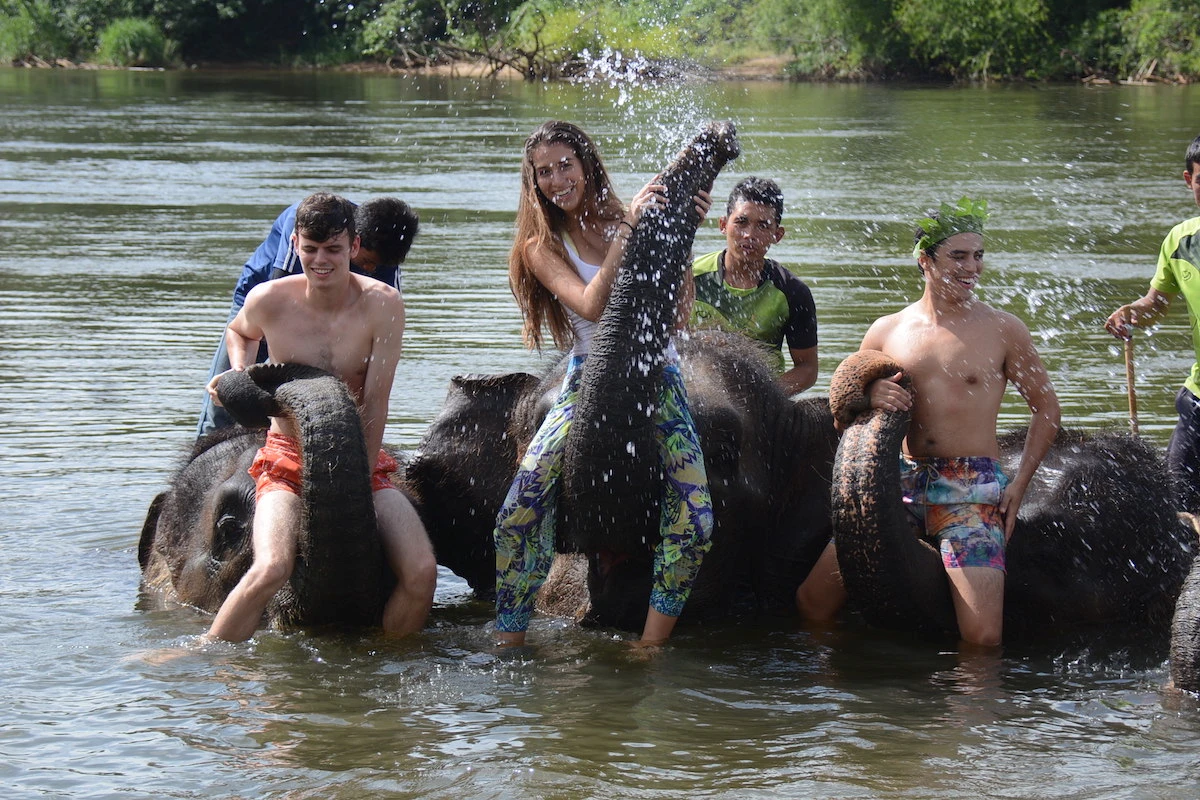
Attractions information
Ride & Bathe Elephants
In Thailand, elephants are the most revered of all animals and still play an active part within Thai society and culture.
In the past they have been used at the forefront of battles and in more recent times to assist in the logging trade. Now, visitors have the opportunity to ride and bathe them.
Despite their vast size, elephants are remarkably agile and are particularly adept at negotiating the narrow tracks in the forest. It's a little nerve wracking, especially when they are going downhill and so make sure you hold on tight.
They often pause along the way, bending far out to pluck some tasty morsel, oblivious to you perched high on their back.
The mahout will jump off during your trek and invite you to slide down onto the elephant's neck and take control. Be warned that their hair is prickly so shorts are not the best attire for this experience.
And also you will be able to bathe the elephants in the waters of the local river. You'll get wet, so don't forget your swimmers. We'll provide the life jackets for you if you want.
Important Information
Not every tour includes bathing the elephants. Please check the Tour Programme.
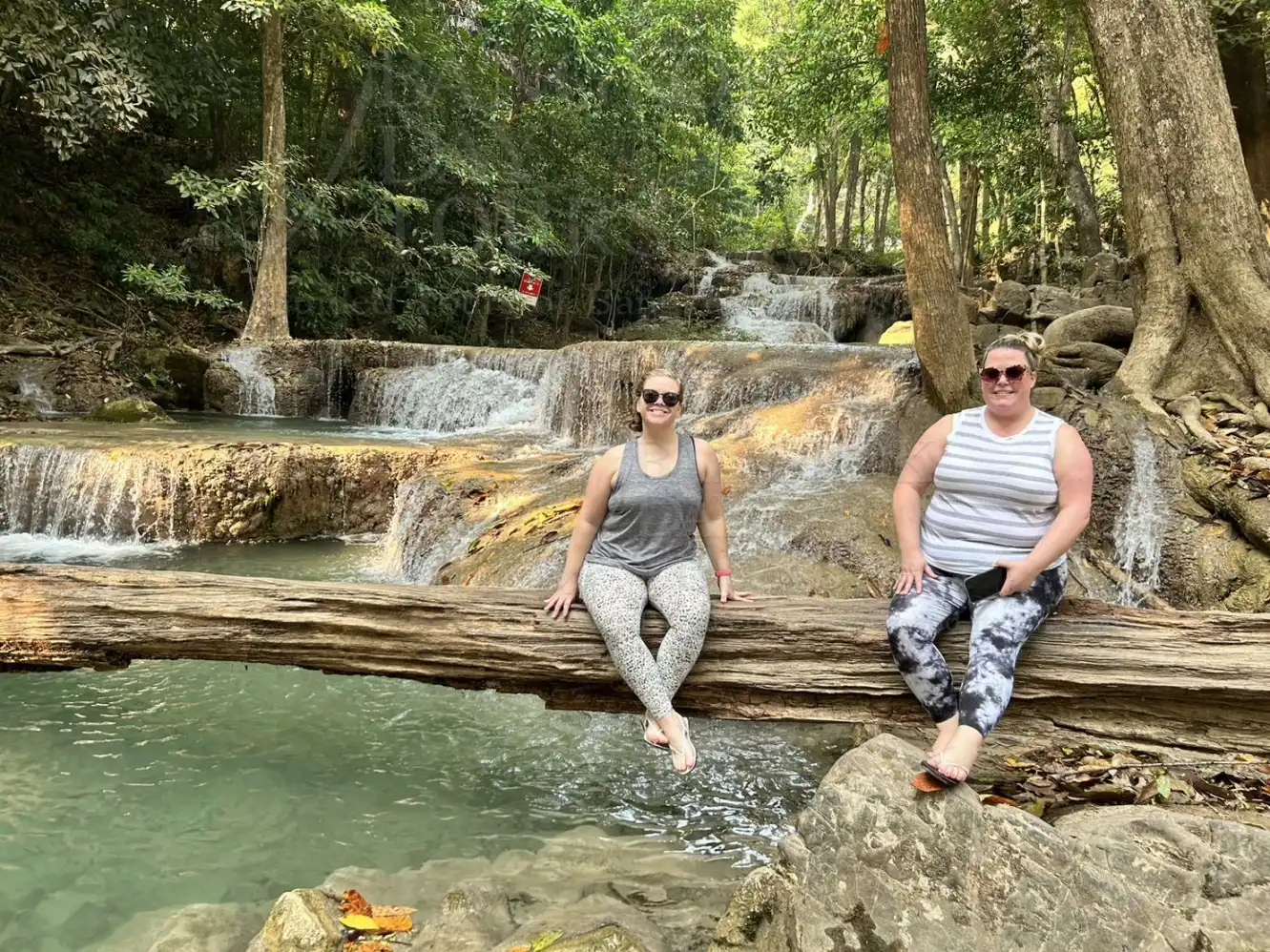
Attractions information
Bamboo Rafting
Bamboo Rafting is another way for relaxing to appreciate the stunning River Kwai Noi in Kanchanaburi

Attractions information
Kanchanaburi Province
Kanchanaburi Province which borders Myanmar (Burma) to the north-west is the third largest Thailand's of seventy six provinces.
It is located 130 km west of Bangkok and has a population of about 735,000 of which 54,000 live in Kanchanaburi town itself. This is a most picturesque part of Thailand.
Kanchanaburi town was originally established by King Rama I as a first line of defence against the Burmese, who might use the old invasion route through the Three Pagodas Pass on the Thai-Burma border.
The magnificent landscape & charming beauty of Kanchanaburi have resulted in major tourist attractions including the well-known Erawan Waterfalls, caves which were once inhabited by Neolithic man, pristine national parks, tranquil rivers, virgin forests, and reservoir.
Together, they offer an intriguing experience whether you are visiting for the first-time or returning for another visit.
Whatever your personal interest: fishing, rafting, canoeing, mountain biking, bird-watching, star-gazing, golfing, elephants, tigers, jungle trekking or even living on bamboo rafts, Kanchanaburi takes pride in offering them all.
Local residents of Kanchanaburi are engaged in agricultural activities as this is one of the most fertile provinces. Most of the locals are of Thai ancestry with notable Mon and Karen minorities.
Kanchanaburi Three Day Tour Combo B (Code:3101)
Pick a day and people
THB 32,900.00
THB 38,900.00
THB 44,900.00
THB 51,900.00
THB 63,900.00
THB 75,900.00
THB 86,900.00
THB 98,900.00
THB 115,900.00
THB 127,900.00
THB 139,900.00
THB 151,900.00
This tour is not designed for cruise ship passengers. Exclusive cruise ship tours are available from Klong Toey Port and Laem Chabang Port.
Kanchanaburi is one of Thailand's largest provinces, and you can cover most of its major attractions in three days. Take a boat through the floating market. Walk along the Death Railway. Enjoy a unique experience by riding and bathing elephants. Bamboo Rafting. Cub Feeding. Bridge over River Kwai. Erawan Waterfall.
Do you want your tailor-made tour?
A tailor-made tour is the best kind of independent travel itinerary, designed and arranged just for you and your needs.
All events and activities are part of your very personal, privately guided tour.
Just ask us and we will be happy to make your tour an unforgettable experience. We have been doing this for 25 years and the quality of tailor made tours has never changed.
Why is a private tour a better choice?
With a private tour, you have the freedom to choose what you want to do and when you want to do it. There is much more room for flexibility and changes to your itinerary at every step of the way because you don't have to consider the needs of other travelers. The flexibility and freedom to make the most of your time is the reason why so many people choose to take a private tour rather than a group tour.Private Tours vs Join Tours:
Bangkok Day Tours does not run join tours. All our tours are private tours, meaning that the vehicle is for the exclusive use of your group throughout the duration of your tour. This allows you to set your own pace and to move along when you have seen enough. No waiting for the stragglers! The only exception to the ANZAC Day Tours which are run on a join basis in April each year.Tour Programme
07:00 - Day 1 Departs.
07:00 - Pick-up from Hotel
Please wait in the lobby of your hotel. We'll meet you there.
08:30 - Floating Market Damnoen Saduak
We'll stop on the way so you can take a boat ride through the floating market. This is probably Thailand's most photographed place and they have lots of tasty snacks which you can buy from the boats as you pass.Read More >
11:15 - War Cemetery Kanchanaburi
First stop in Kanchanaburi will be at the Don Rak War Cemetery where the local guide will join you.Read More >
12:00 - Lunch in Thai Restaurant
We'll stop for lunch in one of the local Thai restaurants.Read More >
12:45 - Tiger Cub - Wildlife Sanctuary Safari
Tiger Cubs - You'll be able to feed the tigers. Getting them to respond to simple commands is a very rewarding experience.Read More >
15:00 - Walk along Death Railway
This was rated one of the best rail journeys in the world and you'll especially like the Wang Pho Viaduct which clings to the cliff face with the river far below.Read More >
17:30 - Check-in to your Kanchanaburi Resort
Time to check-in to your resort for the night. Have a shower and relax before dinner
19:00 - Dinner at the Resort
Relax and enjoy the variety of Thai cuisine in the Restaurant at the Resort.Read More >
08:30 - Day 2 Departs.
08:30 - Depart for Hellfire Pass
After breakfast we'll head up to Hellfire Pass which is 80 km north of Kanchanaburi town.
09:30 - Hellfire Pass & Konyu Cutting
The museum is one of the best in the country and gives an insight into the construction of the 'Death Railway' connecting Thailand and Burma. You can also walk down into Konyu Cutting and see for yourself the work done by WWII Prisoners of War.Read More >
12:00 - Lunch in a Thai Restaurant
Now that you have worked up an appetite, we'll stop for lunch on the way to the Tiger Temple.
13:30 - Ride & Bathe Elephants
After lunch we'll take you to the elephant camp where you can experience the unique 'elephants walk'. From there you can head straight for the river for bath time. The elephants love a good scrub!Read More >
15:00 - Bamboo Rafting on the River Kwai
Now that you are well wet, you can take the bamboo raft for a gentle float down the river. We'll pick you up at the other end.Read More >
16:00 - Return to your Resort
Time to relax. Have a swim and enjoy the variety of Thai cuisine in the Restaurant at the Resort.
08:00 - Day 3 Departs.
08:00 - Erawan National Park
After a good breakfast you'll be ready for some exercise, so we'll take you into the Erawan National Park for a trek through the jungle to the beautiful terraced Erawan waterfalls. You'll have time to relax with a swim here or just a paddle if you prefer.Read More >
12:00 - Picnic Lunch
We'll pack a picnic lunch so when you're hungry just say and lunch will be there.
13:00 - Erawan Seven Tier Waterfall
After lunch you can climb the tiers of the waterfall. There are seven in all but most people do not get to the top. The pools have lots of fish which like to nibble at your legs - Thai massage!
15:30 - Return to Bangkok
It's quite a journey back to Bangkok so we'll leave around 3:30pm.
18:30 - Arrive back at your Hotel
You can expect to be back at your hotel in Bangkok around 6:30pm depending on the traffic.
Important Information
Tiger Cubs will be one of three difference species ‘Leopard, Lion or Tiger cubs seasonal. Depend on the time when we’ll visit! Bamboo Rafting on the River Kwai is available more than 4 people!





